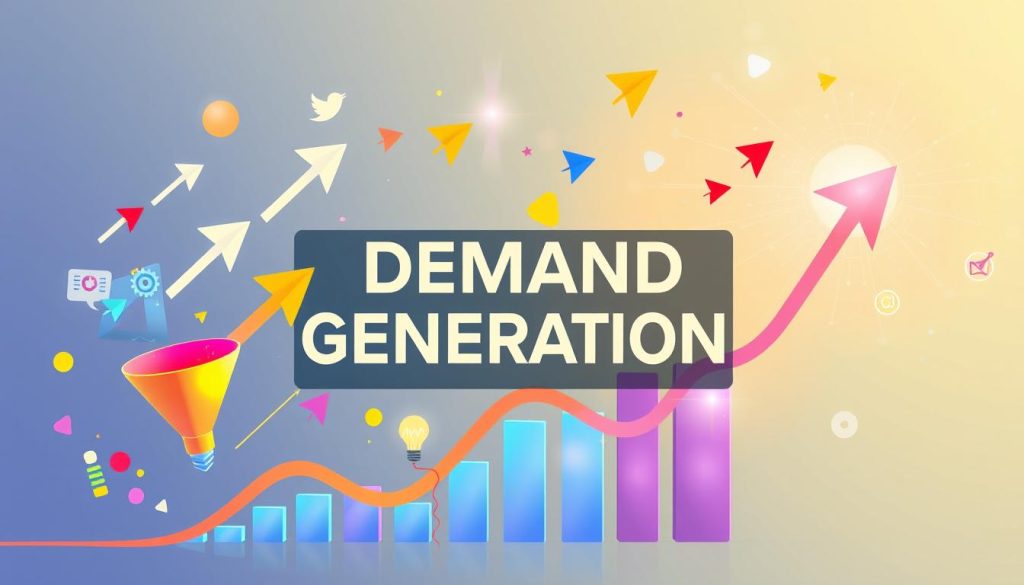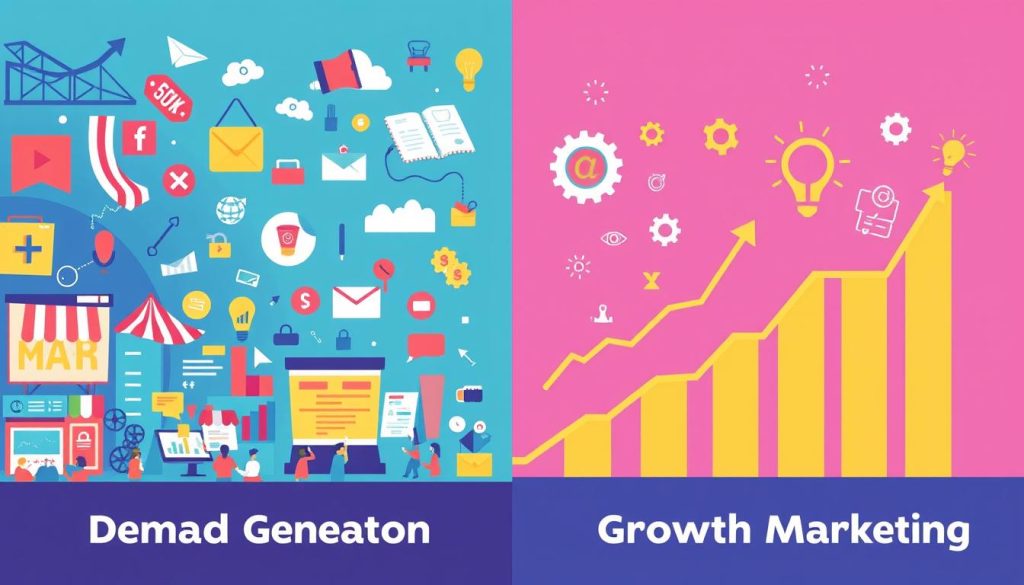Marketing has two powerful approaches: demand generation and growth marketing. Both aim to expand customer bases and boost revenue. However, they differ in strategies, tactics, and goals.
Understanding these differences is vital for businesses. It helps them optimize marketing efforts and achieve sustainable growth.
Demand generation, or inbound marketing, attracts potential customers through compelling content. It uses SEO and lead nurturing strategies. This approach creates a steady stream of qualified leads.
It positions the brand as a trusted resource. It also builds long-term relationships with customers.
Growth marketing takes a data-driven, scientific approach to expansion. It involves rapid experimentation and rigorous testing. Growth marketers focus on key metrics and performance indicators.
They constantly iterate and optimize their tactics. This helps identify the most effective channels for driving sustainable growth.
Key Takeaways
- Demand generation and growth marketing are distinct marketing approaches with different objectives and strategies.
- Demand generation focuses on attracting and nurturing qualified leads, while growth marketing emphasizes rapid experimentation and optimization to drive sustainable growth.
- Understanding the key differences between these two approaches is crucial for businesses to align their marketing efforts with their specific growth goals.
- Effective marketing strategies often involve a combination of demand generation and growth marketing tactics, tailored to the unique needs and challenges of the business.
- Choosing the right approach, or balancing the two, can have a significant impact on a company’s ability to acquire new customers, retain existing ones, and achieve long-term success.
Understanding the Fundamentals of Marketing Evolution
Marketing has changed dramatically over the years. It’s moved from traditional methods to today’s dynamic digital landscape. This shift stems from tech advances, changing consumer habits, and new marketing strategies.
The Shift from Traditional to Digital Marketing
Businesses once relied on print ads, TV commercials, and direct mail. Now, the internet and digital devices have changed how consumers interact with brands.
Today, businesses focus on digital channels. They use customer acquisition, sales funnel optimization, and content marketing to connect with audiences.
Why Modern Businesses Need Specialized Marketing Approaches
- The digital landscape evolves constantly, with new platforms and consumer preferences emerging quickly.
- Customers demand personalized experiences across multiple touchpoints.
- Data-driven decision-making and measurable results are crucial for staying competitive.
- Specialized approaches like demand generation address unique challenges in modern business.
Understanding these shifts helps businesses navigate the changing landscape. They can acquire customers, optimize sales funnels, and create compelling content.
By embracing specialized approaches, companies can effectively reach their target audience. This leads to better engagement and stronger relationships with customers.
What is Demand Generation?
Demand generation creates awareness and interest for a company’s products or services. It’s a key part of marketing strategy. This approach drives brand awareness and lead generation efforts.
The goal is to stimulate demand for a company’s offerings among its target audience. Various marketing tactics work together to achieve this. These include content marketing, social media, SEO, and lead generation campaigns.
Demand generation aims to boost brand awareness and establish industry thought leadership. It generates high-quality leads that are more likely to convert. Also, it enhances inbound marketing by attracting potential customers.
Digital marketing channels help build a pipeline of qualified leads. These leads are ready to engage with the sales team. This leads to more sales opportunities and business growth.
| Key Elements of Demand Generation | Description |
|---|---|
| Content Marketing | Creating and distributing valuable, relevant, and consistent content to attract and engage the target audience. |
| Lead Capture | Implementing strategies to collect contact information from potential customers, such as landing pages, forms, and lead magnets. |
| Lead Nurturing | Engaging with leads through personalized communication, educational content, and automated workflows to guide them through the sales funnel. |
| Marketing Automation | Leveraging technology to streamline and optimize demand generation processes, such as email marketing, lead scoring, and campaign management. |
Mastering demand generation helps businesses build brand awareness effectively. It generates high-quality leads and drives inbound marketing success. This approach is crucial for long-term business growth.

Growth Marketing: A Comprehensive Overview
Growth marketing drives sustainable business expansion through scientific methods. It’s a data-driven approach that experiments, analyzes, and optimizes to improve product-market fit. This strategy also enhances customer retention and accelerates customer acquisition.
The Scientific Approach to Growth
Growth marketing relies on data and iteration, not intuition. It prioritizes constant experimentation and analysis. This process uncovers insights that can lead to exponential business growth.
Key Metrics and KPIs in Growth Marketing
- Acquisition Rate: Tracks the effectiveness of customer acquisition strategies.
- Activation Rate: Measures the successful onboarding and engagement of new customers.
- Retention Rate: Monitors the ability to retain and keep customers over time.
- Referral Rate: Evaluates the willingness of customers to recommend your product or service.
- Revenue Growth: Assesses the overall financial impact of growth marketing initiatives.
The Role of Experimentation
Continuous experimentation is crucial in growth marketing. It helps identify the most effective strategies for sustainable growth. This method allows for quick learning and data-driven choices.
Growth marketers use this approach to optimize key metrics. These include product-market fit, customer retention, and customer acquisition.

“Growth is a science, not an art. It’s the result of systematic experimentation and data-driven decision-making.”
Demand Generation vs Growth Marketing: Key Differences
Demand generation and growth marketing both drive business growth, but their approaches differ. Demand generation targets potential customers through content marketing. Growth marketing spans the entire sales funnel, using data-driven techniques to acquire and retain customers.
Here are the key differences between demand generation and growth marketing:
- Scope: Demand generation creates awareness and interest. Growth marketing covers the entire customer lifecycle, from acquisition to retention.
- Metrics: Demand generation measures website traffic, lead generation, and content engagement. Growth marketing focuses on customer acquisition cost, lifetime value, and conversion rates.
- Tactics: Demand generation uses content marketing, SEO, and social media. Growth marketing employs A/B testing, email marketing, and personalized campaigns.
These strategies can work well together. By aligning them, businesses can create a marketing framework that drives sustainable growth.
| Demand Generation | Growth Marketing |
|---|---|
| Top-of-funnel focus | Full-funnel approach |
| Content marketing, SEO, social media | A/B testing, email, personalization |
| Metrics: traffic, leads, engagement | Metrics: CAC, LTV, conversion rates |

Knowing these differences helps businesses develop better marketing strategies. They can address both short-term and long-term growth goals more effectively.
Strategic Goals and Objectives
Demand generation and growth marketing have different strategic goals and objectives. Understanding these differences helps businesses optimize their marketing efforts. It’s key for driving sustainable success.
Short-term vs Long-term Impact
Demand generation strategies focus on customer acquisition and lead generation in the short term. They aim to attract potential customers and guide them through the sales funnel.
Growth marketing takes a long-term view. It emphasizes brand awareness and ongoing optimization for sustained growth.
Budget Allocation Considerations
Demand generation often needs a higher initial investment. This includes content creation, advertising, and lead generation campaigns.
Growth marketing requires a more balanced budget allocation. Resources go towards experimentation, data analysis, and ongoing optimization.
Team Structure and Responsibilities
- Demand generation teams may be more specialized, with distinct roles for content creators, paid media specialists, and lead nurturing experts.
- Growth marketing teams tend to be more cross-functional, with a emphasis on data analysis, experiment design, and collaborative decision-making.
| Demand Generation | Growth Marketing |
|---|---|
| Short-term customer acquisition and lead generation | Long-term brand awareness and sustained growth |
| Higher initial investment in tactics like content and advertising | Balanced budget allocation, with resources for experimentation and optimization |
| Specialized team roles (content, paid media, lead nurturing) | Cross-functional team with emphasis on data and experimentation |
The strategic goals of demand generation and growth marketing need careful consideration. They must align with a business’s unique needs and challenges.
By grasping these differences, companies can create a strong marketing approach. This drives both immediate results and long-term, sustainable growth.

Tools and Technologies
Marketing success hinges on using the right tools and technologies. These tools boost customer retention, improve product-market fit, and enhance inbound marketing. They include data analytics and automation platforms that optimize strategies and outperform competitors.
Customer relationship management (CRM) systems are vital for customer retention. They centralize customer data, track interactions, and personalize communication. CRMs offer insights into customer preferences and pain points, helping businesses refine their offerings.
Product analytics tools are crucial for achieving product-market fit. They collect and analyze user data, revealing how customers interact with products. These insights help businesses identify friction points and popular features, guiding product improvements.
Content management systems (CMS) and marketing automation platforms are essential for inbound marketing. They streamline content creation, distribution, and tracking. These tools deliver personalized experiences to audiences and automate marketing tasks.
Leveraging these tools can transform businesses’ marketing efforts. They provide data-driven insights and automation capabilities. This empowers organizations to navigate the marketing landscape with precision and efficiency.
“Embracing the right tools and technologies is crucial for businesses to stay competitive and deliver exceptional customer experiences in today’s fast-paced, digital-first environment.”
Measuring Success: Metrics That Matter
Marketing success goes beyond high lead numbers or sales. It’s about understanding strategy impact and effectiveness. Identifying the right metrics is crucial for measuring progress in demand generation and growth marketing.
Demand Generation KPIs
Demand generation builds awareness and interest in your offerings. To measure success, focus on these key metrics:
- Lead generation: The number of qualified leads your campaigns have generated.
- Website traffic: The number of visitors to your website and the sources of that traffic.
- Content engagement: The level of engagement with your content, such as downloads, shares, and comments.
- Marketing qualified leads (MQLs): The number of leads that are deemed ready for sales outreach.
Growth Marketing Success Indicators
Growth marketing optimizes customer acquisition and drives sustainable growth. Key metrics to track include:
- Customer acquisition cost (CAC): The cost of acquiring a new customer.
- Customer lifetime value (CLV): The total value a customer brings to your business over their lifetime.
- Conversion rates: The percentage of website visitors who take a desired action, such as making a purchase or signing up for a service.
- Retention and churn: The rate at which customers continue to use your product or service, and the rate at which they stop.
These metrics offer insights into your marketing strategies’ effectiveness. They reveal the impact of lead generation, customer acquisition, and sales funnel tactics.
By analyzing these metrics, you can make data-driven decisions. This approach helps optimize your marketing efforts for long-term success.
| Demand Generation KPIs | Growth Marketing Success Indicators |
|---|---|
| Lead generation | Customer acquisition cost (CAC) |
| Website traffic | Customer lifetime value (CLV) |
| Content engagement | Conversion rates |
| Marketing qualified leads (MQLs) | Retention and churn |
“Measure what matters, not what’s easy.” – John Doerr
Implementation Challenges and Solutions
Adopting demand generation or growth marketing strategies can be challenging. Yet, with the right approach, these obstacles are surmountable. One key challenge is creating captivating content that resonates with your audience.
To address this, focus on producing high-quality, informative content. Make it visually engaging and offer genuine value to your customers. This will help you stand out in the market.
Building brand awareness is another common hurdle, especially in competitive markets. Use a mix of digital marketing tactics to increase your visibility. Social media campaigns, influencer partnerships, and targeted advertising can help reach new customers.
Deliver a cohesive and authentic brand message across all touchpoints. This is crucial for establishing a strong brand identity. It helps customers recognize and trust your brand.
Retaining customers is an ongoing concern for businesses. Implement effective customer retention strategies to build a loyal customer base. Personalize your interactions and offer excellent customer service.
Gather feedback regularly to improve your products or services. Use customer loyalty programs and targeted retention campaigns. These encourage repeat business and foster long-term relationships with your customers.




